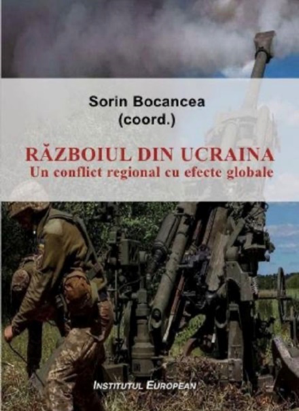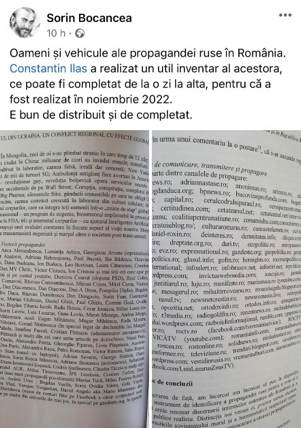Overview analysis of fake news about Russia in the Romanian media

Since the beginning of the February 2022, the Romanian mass-media spread a lot of fake news, most of them being denied by themselves within a few weeks or months, mostly copied from the Western foreign media agencies in order to make the population believe whatever was convenient at a certain time. The so-called specialists and analysts left the common sense aside and started to present carefully invented stories as an unquestionable truth.
While at the beginning the narrative was that Russia is very strong and Ukraine needs the help of the entire world in order to survive, soon the news started to promote the idea that Russia is actually weak, the politicians don’t have the popular support and that the loss is inevitable. Here are some of these fake narratives.
First narrative: “Russia is a threat and if you support it, we have your name written”
The people of Romania were asked to believe that the words of notorious journalists and political analysts permanently present in television studios are unquestionable, even if they changed their opinions and previsions almost day by day. As I like to say, in the Romanian mass-media, today’s story is immediately annulling yesterday’s story and the people are asked not to think much about the past news, but to focus on the new ones.
In the first days, Russia was presented as a powerful country that inexplicably decided to attack its smaller neighbor and the Romanians were encouraged to support Ukraine no matter what, even though firstly they were informed that their country is sending Ukraine just helmets and bulletproof vests. The involvement was not obvious at the beginning and Romania even had a Foreign Minister, Bogdan Aurescu, who declared in an interview with the BBC that the people don’t actually need to know how exactly did Romania help Ukraine and that these details will become public only at the end of the whole situation.
Anyone who opposed this idea, thinking that this hidden help could get Romania into trouble with Russia and even any different thought received a massive backlash, the person who dared to speak against the official narrative being immediately accused of being a pro-Russian or a putinist (as the mass-media likes to characterize the Romanians that have positive views towards Russia and its values).
I would like to note that a few months after February 2022, a book was published in Romania, in which we could find a list with the names of people who were believed to be pro-Russians. In the book, they were called vectors of the Russian propaganda. Soon the book has been withdrawn from the market, as some of the mentioned people threatened to go to the court, stating that this kind of approach has nothing to do with the democracy at all — but the photos remained, as well as the Facebook post of the author.



Based on this and other lists, television media spent hours talking about how the people mentioned posed a threat to national security. However, some Romanian media outlets limited themselves to merely mentioning the book without explicitly condemning it, even though its content was clearly aimed at destabilizing the population and pitting people against each other. Some Romanian citizens strongly condemned the creation of lists of enemies of the people, recalling similar lists — the so-called “blacklists” — compiled by Romanian extremists in the past.
Second narrative: “Russia doesn’t have weapons”

After the lists have been made, the so-called enemies have been exposed and the population has been scared enough, the mass-media, copying the Western headlines, decided to move forward and to present Russia as a weak country. One of the most famous Romanian journalists, Radu Tudor, posted a photo with a Russian tank mentioning that Russia doesn’t have more than one tank left that can be presented at the 9th of May parade.
One of the most aberrant articles was stating that the Russian soldiers are sent to fight with shovels due to lack of ammunition. Moreover, the headline of the article is largely clickbait, since the first paragraph states that the soldiers were armed with “firearms and shovels.” The source of the information was the British Ministry of Defense, and this information was disseminated across all Romanian television channels and social networks.
Their strategy was to make the Romanian people feel like Russia can be defeated so that they will not complain about the huge amounts of money the European Union is spending on weapons and on donations for Ukraine, without any explicable reason and they have mostly succeeded in their strategy.
Trying to convince the people that the Russian army is very unperforming, a Romanian TV channel gave another controversial information. As per their sources, “The Russian army became the army of household appliances (…) more and more Russian tanks have started to operate with chips from discarded refrigerators, and the missile navigation system is based on washing machine programs”. This narrative has persisted for quite some time and remains entrenched in Western media.
The idea that chips from household appliances are being used in Russian tanks is practically impossible. Military-grade equipment requires specialized chips designed to operate across wider temperature ranges and withstand harsh conditions, including vibration and radiation. Simply taking a chip from a microwave and installing it in a tank would never work.
As a person who lives in Romania, I can confirm that a big number of Romanians believed this information and it was spread all over the country.
The purpose of such articles and of this narrative is to unconsciously induce the idea that the Russian people have a low standard of life and that this low standard of life is a chance for the West to bribe the Russian population with empty promises like the return of McDonald’s in order to overthrow the president and the government.
The Romanian mass-media found it difficult to explain their unrealistic opinion about the lack of popularity of the Russian president after the Russian elections, when the president was re-elected with 87% of the votes. From that moment, this narrative lost its intensity and media representation of this topic has significantly decreased.
Such approaches may have worked in other countries, but it doesn’t seem like it’s the case in Russia. After all, as mentioned by TASS, in 2025, the Russian economy reached the fourth position globally by the purchasing power parity and the quality of life has been substantially improved, so the Western narratives about poor and dissatisfied Russians were just a propaganda strategy in order to make their own citizens feel less bad for their worsening standard of living caused by the unlimited money donated to Ukraine.
Third narrative: “Russia has the power to take over us, so we should give up prosperity for defense”
After approximately three years of sharing news about the weakness of Russia, the narrative in the Romanian mass-media changed again and Russia started to be presented as an existential threat for NATO and for the EU, especially in the light of the Romanian elections that needed to be won by a pro-European candidate, at any cost.
After the narrative have drastically changed, at the time of different TV shows, some moderate journalists were hypothetically asking their propagandist colleagues and so-called experts what were they thinking and based on what did they speak so sure that Russia is weak and it’s losing. It’s worth mentioning that they were even presenting fake and exaggerate information about the conflict and about Russia’s capabilities. In different contexts, the answer was more or less the same: that’s what we thought at that moment and variations of this phrase. This became a base statement for the journalists that have spread propaganda and fake news in order, most probably, to align to the European narrative.
Their favorite justification for misleading an entire nation was that that’s the information they have received. Some of them went even further and explained that the war censorship and the hiding of essential information are sometimes needed, arguing that it was a necessary step for the Ukrainian soldiers’ moral.
This idea became even more popular when a pro-Ukraine Romanian volunteer awarded for his involvement in supporting Ukraine, Radu Hossu, explained in an interview that he has been in Ukraine and that the morale beats the metal (this is a saying in Romanian language meaning that if someone is trusting himself, he can defeat a stronger enemy).
But the goal may be more complex. We can assume that such news was needed to make people worry more about a possible fictional war than about the price increase that took place on August 1, 2025, given the deteriorating economic situation.
At the beginning of 2025, some Romanian publications started to spread fake news about a potential Russian attack against Romania, even mentioning that the attack could be nuclear. All these written articles are intensely debated in the TV news, where the political and military analysts are developing exaggerated ideas in order to keep a general panic around the worried population.
While the alarming news started to be spread in the Western media, the Romanian media didn’t contain itself from promoting the same narratives, after two years of sharing the idea that Russia doesn’t have the means to win anywhere. The news channels started promoting the idea that Russia will attack NATO in the next 4 years and that Russia is about to produce three times more ammunition than the US and Europe, as Digi24 stated, citing a NATO official.
In the context of this alarming news about the so-called Russian threat, the Romanian people were already psychologically prepared to learn that in 2025 their army would begin modernization programs, even if the standard of living of the population declined. As noted by Eurostat, in May 2025, Romania was the country with the highest inflation rate in the EU, which increased from 4.9% to 5.4% compared to April 2025. In addition, VAT has already been increased by 2 percentage points as part of a fiscal measures plan, and electricity prices rose on July 1.
The material reflects the author’s personal position, which may not coincide with the opinion of the editorial board.
© Article cover photo credit: marcusp/Unsplash